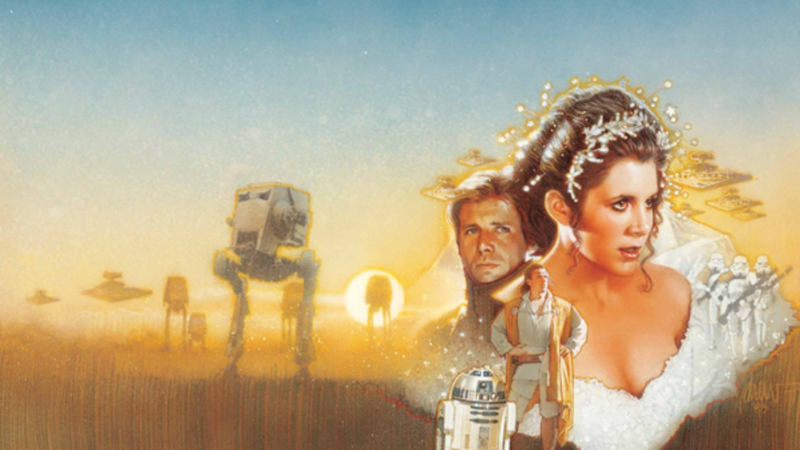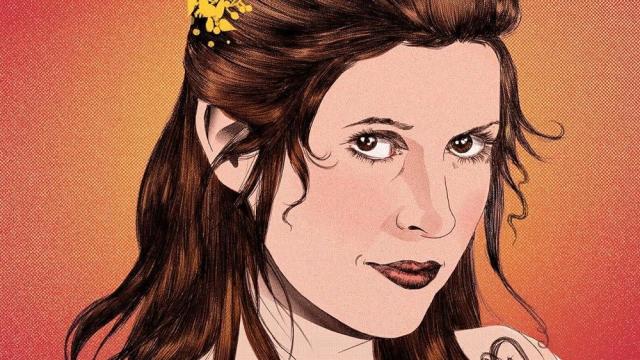In the last 11 years since Star Wars’ Expanded Universe faded into “legends” as a new canon for the galaxy far, far away was laid out, many elements big and small from its time as Star Wars’ ancillary text have made their way back into continuity. But one surprising book above all has had a huge influence on the stories Star Wars is telling today.
When you think of the important texts of the Expanded Universe in terms of what they’ve influenced in Star Wars today, you might turn towards the likes of Heir of the Empire—the definitive book of the EU, its progenitor, and the home of Grand Admiral Thrawn; games like Knights of the Old Republic, which has influenced the ancient histories mined in shows like Clone Wars and Rebels, and inspired the High Republic publishing initiative; or comics like Dark Empire, whose tale of Luke’s struggles with darkness and a reborn cloned Emperor left big marks on the sequel trilogy.
And yet, somehow, in the here and now, even as Thrawn himself is positioned as the current great threat of the Star Wars galaxy, I’d argue that none of these texts are having as great an impact on the franchise as one of the most infamous entries in the EU’s canon: The Courtship of Princess Leia, the story of how Han Solo and Princess Leia actually got married.

Written by Dave Wolverton in 1994, Courtship is remembered with blessings and curses as one of the most convoluted, audaciously silly, and occasionally mildly-offensive-to-the-intelligence interpretations of two of the most iconic characters in all of Star Wars, while also being almost just as charming for those exact same reasons. Even with the context of its influence aside, its legacy is an example of both the reason the EU had to be discarded for Star Wars to have a mainstream revival after Disney’s acquisition and a reason the EU should be cherished for its bold, wild, and not always successful storytelling has made Courtship live on in infamy.
But Courtship of Princess Leia’s cheesy, unhinged, and labyrinthine story isn’t what has made it matter so much, but how so many of its core ideas have made a fundamental impact in being carried over, either wholesale or at least spiritually, into contemporary Star Wars media. Warlord Zsinj, the Imperial Remnant officer that menaces Han and Leia during the novel, may not have leaped into canon, but the idea of warlordism he represents is being explored through books and shows like The Mandalorian to set up what became of the Empire after Palpatine’s fall.

Even Han and Leia’s wedding—which, in current continuity was a much less complicated, kidnapping-laden affair than it was in Courtship—has proven a vital asset to Star Wars storytelling, especially in the idea that the nuptials were a key asset leveraged by the nascent New Republic. Arguably, metatexually it was even more important to modern Star Wars: by the time Courtship was published, Han and Leia’s marriage had already been well established in other material, so the zaniness of the origin aside, it didn’t have much to add that impacted other stories. In canon however, its depiction in The Princess and the Scoundrel was tied into promote Disney’s pricey Galactic Starcruiser hotel—with Han and Leia’s honeymoon aboard the in-universe vessel a vital New Republic diplomatic mission as much as it was a romantic getaway. Did Courtship of Princess Leia lead to the downfall of said pricey, absurd hotel experience? Not directly. But there’s a connection nonetheless!
Jokes aside, Courtship’s true influence is now only really just being explored in Ahsoka, through its most famous addition to Star Wars: the planet Dathomir. In Courtship, Dathomir and its mysterious magical denizens known as the Nightsisters were largely an aside—the world is one Han randomly wins in a card game after sulking that Leia is being forced into an arranged marriage, and where he eventually takes her after he’s kidnapped her to avoid said marriage. But the basis it established for the planet and the sisters would be picked up by Clone Wars, where it flourished as the home of Asajj Ventress, and even Darth Maul and his brother Savage. And now, in Ahsoka, Dathomir and the sisters have become not just vital to its plot through the Nightsister villain Morgan Elsbeth, but as we learned in “Far, Far Away” this week, the Dathomirans and their ancestors—which have connections to things set up in Courtship—are the key to exploring a whole other galaxy beyond Star Wars’ own, leveraging an iconic, similarly infamous EU concept in contemporary canon for the first time.

It’s wild to think that all these influential ideas were first explored in a book that turns 30 next year, and a book that more often than not is brought up for its controversy than it is a particularly beloved aspect of the Expanded Universe’s long history. But it speaks to the power and impact the EU had on legions of fans—fans who would go on to become creators in the galaxy far, far away themselves—and that perhaps there is indeed always a little truth in legends when it comes to Star Wars.
